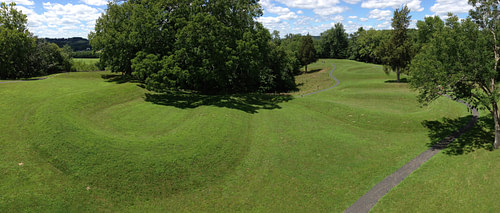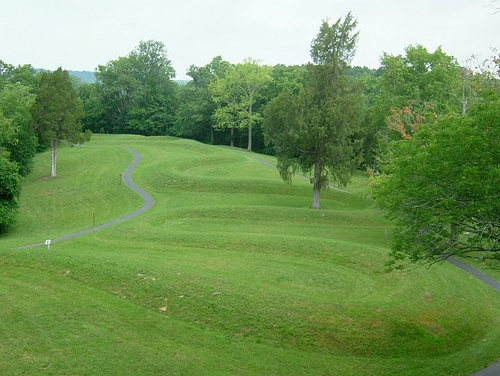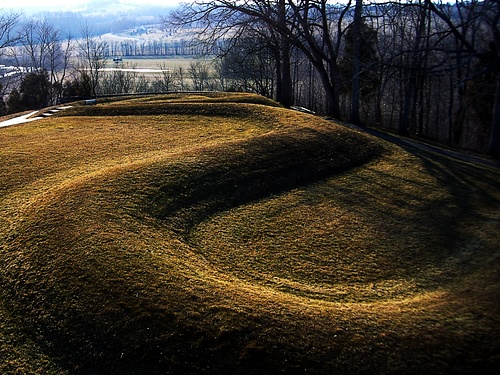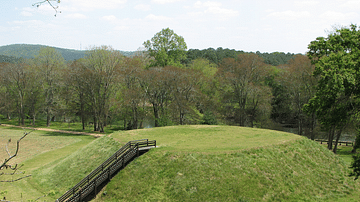
Serpent Mound (also known as Great Serpent Mound) is an archaeological and historic site in Peebles, Ohio, USA, enclosing an effigy mound 1348 feet (411 m) long in the shape of a serpent, the largest effigy mound of a serpent in the world, built between c. 800 BCE and c. 1070 CE.
Dating of the site has been problematic as it was first positively dated and attributed to the Native American Adena culture (c. 800 BCE - 1 CE) but later excavations strongly suggested it was built by the natives of the so-called Fort Ancient culture (c. 1000-1750 CE) and, most likely, around 1070 CE. These dates were both arrived at from artifacts found near the site and carbon dating of charcoal located within the mound.
The debate on the mound’s builders continues but the most reasonable conclusion is that it was started by one culture and completed by the other. This is especially probable as the so-called Fort Ancient culture is dismissed by some scholars as a distinct indigenous culture and is recognized as simply a development of the Hopewell culture (c. 100 BCE - 500 CE), which these same scholars claim was the successor to the Adena culture.
The mound was first noted and mapped in the early 19th century when European and American scholars became aware of the Native American mound sites throughout the eastern United States. In 1846, Serpent Mound was surveyed by the archaeologists Edwin Hamilton Davis (l. 1811-1888) and E. G. Squier (l. 1821-1888) for the Smithsonian Institution and was included in their seminal work on Native American mound sites, Ancient Monuments of the Mississippi Valley (published in 1848), which became the basis for later interpretation of the sites up through the 20th century. Their work encouraged the interest in the site of anthropologist Frederic Ward Putnam (l. 1839-1915), often referred to as the "Father of American Archaeology", who raised the money to purchase and preserve the site which, today, is recognized as a National Historic Landmark and major tourist attraction presently under consideration for inclusion as a UNESCO World Heritage Site.
Mound Sites & Their Builders
Serpent Mound is only one of many sites built by Native Americans between c. 5000 BCE and c. 1450 CE across North America. It is unclear what led to the initial construction of mounds, how many were built, and in some cases, what purpose they served, but prior to the arrival of Europeans on the continent it is thought they numbered in the thousands. The mounds – some over 100 feet (30 m) tall – were all built by cultures who had no beasts of burden and no wheeled vehicles; each was constructed by people carrying bundles of soil in baskets or animal skins which were dumped at a central spot and then shaped by others.
The Native Americans who constructed the mounds were initially all hunter-gatherer societies who were nomadic or semi-nomadic, practicing at best a rudimentary form of agriculture, until they decided to put down roots in a given area and built their mounds, at least some of them, as an expression of religious beliefs. As these communities moved toward a more agrarian lifestyle, and agriculture became the primary food source, they became more stable and sedentary, leading to the rise of enormous urban complexes such as Cahokia. Scholar James Wilson comments:
A limited form of agriculture began to appear about 3,500 years ago, and as it spread to other areas, generating a larger and more settled population, it fueled the development of bigger, more complex societies. The most influential were the 'mound-building' Adena and Hopewell cultures, which built massive earthworks and burial mounds in geometric, plant, and animal forms and developed an extensive trade network across and beyond the region. (46)
The region Wilson references spans the area in the USA from modern-day New York down to Florida, Louisiana, Texas and up through Oklahoma to Wisconsin – all of a relatively similar type – and then further west and north into Canada of different types. The artifacts discovered at these mound sites have provided archaeologists with evidence of significant differences in the cultures that built them, and these cultures are named either for the lands the sites were found on (such as Poverty Point in Louisiana, named for the 19th-century plantation which enclosed it), local tribes (as at Cahokia), or simply as descriptive terms (such as Moundville). One of the most significant of the many cultures living in the Mississippi River Valley was the Adena culture, recognized as among the greatest of the mound builders.
The Adena & Hopewell Cultures
The Adena culture is named for the estate of the 19th-century governor of Ohio, Thomas Worthington, on whose land the mound now known as Adena Mound was discovered. They were a semi-nomadic hunter-gatherer society who eventually came to cultivate crops such as barley, marsh elder, pumpkin, may grass, and knotweed, establishing permanent residences alongside their crops and raising mounds. Some of these were used for burials of the upper class, nobility, and priests, while others have been identified as ceremonial sites, and the purpose of still others is unknown.
The Adena knew how to work metal and created plain, utilitarian ceramics, which, unlike other cultures, were not interred with the dead. The Adena sites almost universally produce no grave goods but a number of artifacts from non-burial sites. The people lived in settlements near or around the mounds in homes made of wood with conical rooftops. The mounds mirrored the homes and were most frequently conical, a feature that has come to define Adena culture mounds.
According to some scholars, the Adena culture was succeeded by the Hopewell (also named for the 19th-century land on which their mounds were discovered) which is thought to differ from the Adena primarily in greater long-distance trade, more intricately ornamented ceramics, and the creation of geometric earthworks known as effigy mounds – mounds in the shape of some animal and sometimes aligned astronomically. The Hopewell culture is also known as the Hopewell tradition because it has become clear there were a number of different cultures, distinct unto themselves, which shared in a larger “umbrella” culture represented by their mound construction in different locations.
The Armstrong culture, for example, lived in Kentucky and West Virginia while the Copena were located in Alabama, Mississippi, and Tennessee but both built the same kinds of mounds and created similar ceramics. There is no universal agreement on the claim that the Hopewell succeeded the Adena as some scholars believe the Hopewell were simply a development of the Adena and not a 'new' culture. This same sort of debate continues regarding another associated with Serpent Mound, the Fort Ancient culture.
Fort Ancient Culture
Fort Ancient culture is named after the archaeological site in Ohio – Fort Ancient – another 19th-century designation for a site which was interpreted as an ancient fort. This interpretation has been challenged and revised since later investigation and excavation showed the site could not possibly have been built for defense and was more likely a ceremonial site. The designation of Fort Ancient culture as a distinct culture has also been challenged as the Fort Ancient site has also now been understood as a product of the Hopewell tradition, not a 'new' culture that emerged later, and so – to some scholars – Fort Ancient culture is an obsolete designation as the site was not a fort and the culture was not distinct from the Hopewell.
Even so, 'Fort Ancient culture' is still used in discussing the sites associated with the late Hopewell tradition because a significant body of scholarly work has used that term. It should also be noted that there remains a scholarly school of thought which still claims the Fort Ancient culture was distinct from the Hopewell. Whoever these people were, they created effigy mounds and ceramics in the images of animals such as turtles, salamanders, and serpents among others, and also included grave goods in the internment of their dead. These grave goods show little variation, which suggests Fort Ancient was an egalitarian society with no social hierarchy or, at least, a fairly fluid social stratification. Artifacts recovered from Fort Ancient sites suggest a belief in an afterlife, higher powers, and the potency of images of totemic animals, and this is also reflected in the shapes of the mounds they built.
Native American Religion & Serpents
Native American religion, generally, was an expression of animism – the belief that all things contained an animating spirit and were connected in a network of reciprocity – and central to the concept of animism is spiritual power. Wilson notes:
The common thread running through every level of East-coast society and every aspect of Indian life was the ubiquitous belief in 'power'…in a universe where every human act has spiritual ramifications and can affect the well-being of the people, there is no clear-cut boundary between 'sacred' and 'secular'…Contacts and movements between [the earthly and spiritual realms] had to be mediated through rituals and gift exchanges which acknowledged the respective positions of the two sides and committed them to fulfilling their mutual obligations. (53)
An example of this would be thanking a tree one has cut down for lumber or an animal one has killed for food in giving their spirit for one’s benefit. The individual, and community, would ritually give thanks for these kinds of gifts through ceremonies and, based on artifacts discovered at the various sites, these ceremonies frequently were enacted on the tops of mounds which, according to some scholars, may have been built to focus, contain, or control spiritual energies in a given locale. The communal effort that went into building the mound would be a form of thanksgiving to the spirits of the place which, in turn, would reside or center themselves in the mound and give back to the people.
The so-called Fort Ancient culture seems to have paid special attention to honoring the spirit represented in the serpent because snakes seem to have been regarded as symbols of transformation. In shedding its skin, the snake became a new snake, leaving its old form behind and, in the same way, an individual could awaken spiritually to a new life through recognition of divine energies and be transformed. It is possible that this understanding of the universe influenced, or directly inspired, the creation of Serpent Mound.
Serpent Mound
Serpent Mound is located in a meteorite impact crater mostly in Adams County, Ohio, formed approximately 3oo million years ago and today known as Serpent Mound Crater. It is possible that the mound builders chose this site for the resonant energies left by the meteorite’s impact but equally possible that the earth-energies – which according to some writers on the subject have always existed in certain areas – drew the people to the site without any special regard for the meteorite or the crater.
The mound has thus far yielded no artifacts which could help in dating it; any artifacts associated with the people who built it have come from surrounding mound sites and areas identified as former villages. The mound was initially attributed to the Adena culture based on graves and artifacts discovered nearby including skeletons unearthed in the 1880s that were buried in accordance with known Adena practices. The fact that no artifacts were discovered in the mound itself also suggested an Adena origin since, as noted, the culture did not bury their dead with grave goods nor include artifacts in their mounds.
Serpent Mound was therefore positively identified with the Adena and given a probable date of c. 321 BCE until the excavation and carbon dating of charcoal found within the mound in the 1990s, which dated the site to c. 1070 CE. This date placed the creation of the mound to the time of the Fort Ancient culture and way past the period of the Adena. Scholars who still favored the interpretation of the Adena as the builders challenged the new claim by suggesting that the charcoal deposit was the result of later efforts at renovation and still maintained Adena provenance.
Other scholars, however, maintain that the charcoal is integral to the original construct of the mound and, dated to 1070 CE, suggest that the mound may have been built as a response to Halley’s Comet which appeared over North America in 1066 CE. The serpent effigy, with its winding coils, is, according to this claim, a representation of the comet. Objections to this claim include the observation that Halley’s Comet has a straight tail – no twists, turns, or coils involved – and so Serpent Mound could not be a "mirror on earth" of the comet overhead.
Some scholars also reject the claim that the Fort Ancient culture built the mound based on the lack of artifacts in the mound and no evidence of Fort Ancient burial practices in the surrounding area. This debate continues in the present day along with what the mound was meant to signify. As noted, the mound stretches 1,376 feet (419 m), with a width of around 25 feet and varying in height to between a foot and three feet. The serpent image has seven coils winding back and forth between a tail and a head, and this head has been interpreted as either a snake swallowing an egg, swallowing the moon (or sun), or not a head at all but a ceremonial plateau on which rituals were conducted. There is no scholarly consensus on the interpretation of the meaning of the head of the snake, and none likely forthcoming.
The serpent’s head is aligned to the summer solstice while the respective coils seem aligned to the solstices and equinoxes. The mound, therefore, suggests astronomical significance and may have been built as means to chart solar and lunar movements while also serving as a symbol for the spiritual energies focused by the mound. Rituals conducted at the head of the serpent (if any) might therefore have been thought more potent in that they were tapping the focused spiritual energies of the area and, coupled with the image of the serpent, encouraged transformation.
Discovery & Excavation
Serpent Mound was first mapped in 1815 from tail to head and, as noted, was later surveyed and included in the well-known work of Davis and Squier. Their work attracted the attention of Frederic Ward Putnam who arrived at Serpent Mound in 1885 and was shocked to find that the site, and those surrounding it, were being threatened – and had even been damaged or destroyed – by agricultural activities engaged in by people who considered them of little worth. Putnam raised the funds necessary to purchase the lands surrounding Serpent Mound to preserve it in 1886, and if it were not for his efforts, the site would probably not exist today.
Putnam devoted himself to the mound sites of Ohio, and especially Serpent Mound, for the next four years. His work, along with that of Davis and Squier, set the model for interpreting the site going forward. Excavations in the 20th and 21st centuries have continually suggested varying dates of construction and evidence of both Adena and Fort Ancient cultures as the architects and builders and debates concerning the meaning and origin of the site continue in the present day, but these arguments have done nothing to diminish or encourage people’s interest in the site.
People interested in astronomical sites, ancient history and culture, ancient aliens, Native American religion, ancient architecture, and many other spheres of inquiry have been drawn to the site over the years. In 1967, the Ohio Historical Society created paved paths around the mound for visitors and established the Serpent Mound Museum which features exhibits on the Adena and Fort Ancient cultures as well as other Native American nations who lived in the area. The site is designated a National Historic Landmark and continues to draw visitors from around the world annually who are as fascinated by the great mound today as its 19th-century admirers were in theirs.








